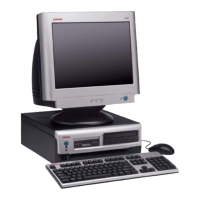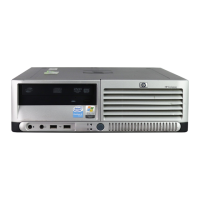Chapter 6 Integrated Graphics Subsystem
6.2.1 VIDEO MEMORY ALLOCATION REPORTING
The IGC does not have local memory at its disposal but instead uses a portion of system memory
allocated for frame buffering and texturing. The total memory allocation is determined by the
amount of system memory installed in a system. The video BIOS pre-allocates, during POST, a
user-selectable amount (512 KB, 1 MB, or 8 MB) of system memory. This pre-allocation is
primarily for compatibility with legacy VGA operation (i.e., DOS operations that do not use the
IGC’s Extreme Graphics drivers). System memory that is pre-allocated is not seen by the
operating system, which will report the total amount of memory installed less the amount of pre-
allocated memory.
Example: A system with 128 MB of SDRAM with the video BIOS set to 8 MB will be reported
by MS Windows as having 120 MB.
The IGC will use, in standard VGA/SVGA modes, pre-allocated memory as a true dedicated
frame buffer. If the system boots with the OS loading the IGC Extreme Graphics drivers, the pre-
allocated memory will then be re-claimed by the drivers and may or may not be used by the IGC
in the “extended” graphic modes. However, it is important to note that pre-allocated memory is
available only to the IGC, not to the OS.
The 865G’s DVMT function is an enhancement over the Unified Memory Architecture (UMA) of
earlier chipsets. The DVMT of the 865G selects, during the boot process, the maximum graphics
memory allocation possible according on the amount of system memory installed:
SDRAM Installed
Maximum Memory Allocation
< 256 megabytes 32 MB
>
256 megabytes 48 MB
The actual amount of system memory used by the IGC (in the “extended” or “extreme” modes)
will increase and decrease dynamically according to the needs of the graphics application. The
amount of memory used solely for graphics (video) may be reported in a message on the screen,
depending on the operating system and/or applications running on the machine.
For viewing the maximum amount of available frame buffer memory MS Windows NT 4.0, go to
Display Properties > Settings> Advanced, and click on the Adapter tab. For viewing the
maximum amount of available frame buffer memory MS Windows 2000 or XP, go to Display
Properties > Settings> Adapter.
The Microsoft DirectX diagnostic tool included in most versions of Windows may be used to
check the amount of video memory being used. The Display tab of the utility the “Approx. Total
Memory” label will indicate the amount of video memory. The value will vary according to OS
(Windows 98 will typically show 0.5 to 5 MB or higher, depending on screen resolution and
application. In Windows 2000 or XP, the video memory size reported by DirectX will always be
32 MB, even if the total memory installed is over 128 MB.
NOTE: Some applications, particularly games that require local graphics memory, may
not install or run on systems using the IGC.
hp compaq d330 and d530 Series of Personal Computers
Featuring the Intel Pentium 4 Processor
First Edition - June 2003
6-4

